Rodent Control & Monitoring.
Rodent Control - CLICK HERE
Indigenous Rodent Protection & Monitoring - CLICK HERE
Rodent-borne Disease Monitoring - CLICK HERE
For years now it has been drummed into man that the only efficient way of rodent control is poison/rodenticide. This myth has been perpetuated by the pharmaceutical giants and their allies the pest control companies and aided by the laziness and cheap nature of the corporations using their services.
The end result has been the decimation of our rodent eating predators and an ever increasing exotic rodent population!
To control rodents a basic understanding of the “beast” and what makes it such a “survivor and thriver” is needed.
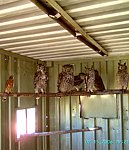
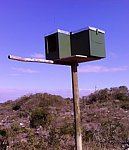

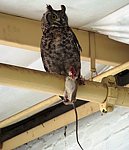
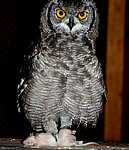
We use a variety of traps indoors and an arsenal of indigenous predators on the outside. Establishing owls and other predators in poison-free areas is our speciality and we successfully manage among others the Nelson Mandela Metro 2010 World Cup Stadium, the Port of Ngqura and numerous other sites in this manner. We also use Rat, English Fox and Jack Russell terriers in the oldest traditional form of rodent control.
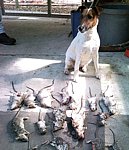
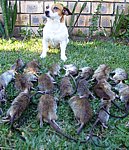
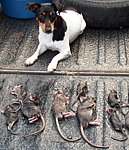

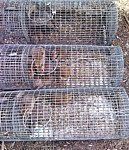
Rule 1: Know thy enemy
Norwegian/brown rat [Rattus norvegicus]
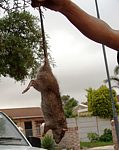
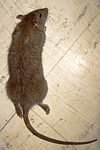 This is the biggest and meanest of the exotic rats. Protein is a big dietary component and they kill other rodents, birds and small mammals. They have been recorded as “pack hunting” and killing young lambs and piglets. I have witnessed them on numerous occasions turn and fight when pursued by terriers. My personal record kill was a male with a 67 centimetre OAL and weighing in at a hefty 693 grams. The world record brown rat weighed in at 4.5 kg and was killed in Madagascar about a year ago. And to top it all the brown rat is a man-eater not hesitating to attack infants and weak humans! Brown rats are the ancestors of the domesticated laboratory rat/pet rat. Although brown rats are widely distributed in the rest of the country, in P.E at present the brown rat only occurs in Central. The rest of our area is under black/house rat control.
This is the biggest and meanest of the exotic rats. Protein is a big dietary component and they kill other rodents, birds and small mammals. They have been recorded as “pack hunting” and killing young lambs and piglets. I have witnessed them on numerous occasions turn and fight when pursued by terriers. My personal record kill was a male with a 67 centimetre OAL and weighing in at a hefty 693 grams. The world record brown rat weighed in at 4.5 kg and was killed in Madagascar about a year ago. And to top it all the brown rat is a man-eater not hesitating to attack infants and weak humans! Brown rats are the ancestors of the domesticated laboratory rat/pet rat. Although brown rats are widely distributed in the rest of the country, in P.E at present the brown rat only occurs in Central. The rest of our area is under black/house rat control.
The black/house rat [Rattus rattus]
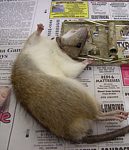
 The most prevalent exotic rodent of our area with two subspecies occurring the Frugivorous [distinctive white belly] rat along the coast and Alexandrine rat in the drier interior. These rats are arboreal artists capable of running up walls with the aid of their long prehensile tails and make monkeys seem quite clumsy. If there is rat activity in a roof it’s going to be roof/house rats. Their staple diet is fruit, seed and vegetable matter and they carry the distinction of being the rat that brought man to his knees. The once deadly ‘Plague’ aka ‘Black death’ was spread throughout the known world by these rats.
The most prevalent exotic rodent of our area with two subspecies occurring the Frugivorous [distinctive white belly] rat along the coast and Alexandrine rat in the drier interior. These rats are arboreal artists capable of running up walls with the aid of their long prehensile tails and make monkeys seem quite clumsy. If there is rat activity in a roof it’s going to be roof/house rats. Their staple diet is fruit, seed and vegetable matter and they carry the distinction of being the rat that brought man to his knees. The once deadly ‘Plague’ aka ‘Black death’ was spread throughout the known world by these rats.
The house mouse [Mus musculus]
 Stinky little home dwelling pest adequately describes this mouse. As the male walks he urinates, leaving about 4 liters of urine per year behind. He will probably be smelt before he is seen! House mice are very territorial and occupy small territories of a few square meters. House mice are the domesticated pet mice’s wild ancestors.
Stinky little home dwelling pest adequately describes this mouse. As the male walks he urinates, leaving about 4 liters of urine per year behind. He will probably be smelt before he is seen! House mice are very territorial and occupy small territories of a few square meters. House mice are the domesticated pet mice’s wild ancestors.
Indigenous Rodent Protection & Monitoring
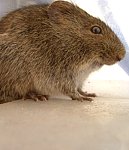
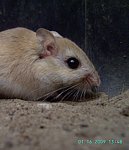
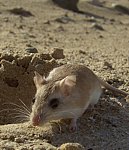
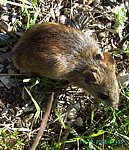
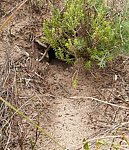
Urban Raptor Project prides itself on wherever possible encouraging the protection of our indigenous rodent species. Our work protecting the endemic and possibly threatened Pigmy hairy-footed gerbil in the Port of Ngqura has attracted international attention and featured on wildlife film documentaries and programs both locally and internationally.
Thanks to our pioneering poison-free work indigenous rodents in the areas we work in are not indiscriminately poisoned. Instead they form part of the natural food chain and consumption of them by indigenous predators does not threaten their survival. Neither does it expose those predators to the danger of secondary rodenticide poisoning.
We use live-traps in our rodent monitoring and all species are identified, sexed, aged and released .A minimal amount are sampled for purposes of rodent-borne disease monitoring.
We are able to monitor population densities and have already built up years of data in some of the areas we are contracted to sample.
Rodent-borne Disease Monitoring
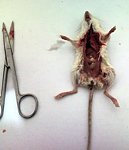
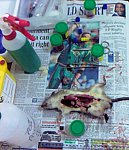 Urban Raptor Project has the equipment and expertise to collect samples for rodent-borne disease monitoring. This is a function we carry out for some of our clients in rodent-borne disease threat areas. Samples are tested and analysed by the National Institute for Communicable Diseases.
Urban Raptor Project has the equipment and expertise to collect samples for rodent-borne disease monitoring. This is a function we carry out for some of our clients in rodent-borne disease threat areas. Samples are tested and analysed by the National Institute for Communicable Diseases.
Rats have been identified as carrying over 70 diseases known to affect man and to quote the WHO “Rats are the biggest health time bomb facing the human race”.
Residents of cities are a newly identified population at risk for a bacterial disease carried by rats according to a Nov. 15 Annals of Internal Medicine study led by Joseph M. Vinetz, M.D., a postdoctoral fellow in the National Institute of Allergy and Infectious Diseases (NIAD)"Our results suggest that leptospirosis may be yet another re-emerging infectious disease in urban United States," he and his co-authors conclude. "Leptospirosis may be the most common disease that rats carry and transmit to humans in the United States," comments Dr.Vinetz, "but it's simply under recognized." Although leptospirosis is not new to the United States, it is difficult to diagnose, hence its prevalence is unknown.
Rat facts
Male rats of both species forage for up to one kilometre from where they live.
A single pair of rats can generate 15 000 offspring in their lifetime.
Black/house rats and Norwegian/brown rats originated in South-east Asia and spread from there [with human assistance] to all continents except Antarctica.
House mice survive in Antarctica by having three times the amount of brown fat [concentrated store of energy and vital for thermal insulation] than normal.
Welcome to our world…..please use the contact form to drop us a line & we will contact you.


